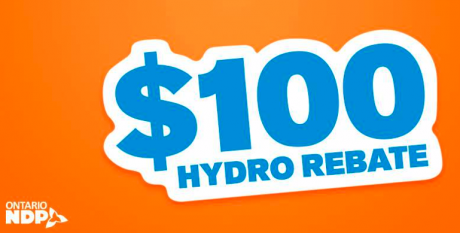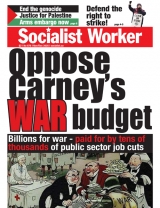Features
You are here
ONDP: WTF?

March 31, 2014
In the aftermath of defeating the Tories in Niagara, which forced an about face by Hudak on “right to work,” you would think the NDP would come out swinging. Instead it is Hudak railing against “corporate welfare” and Kathlynn Wynne speculating about imposing more surtaxes on the wealthy. The Ontario NDP has responded with a pathetic demand to give everyone $100 in hydro rebates. A nice idea but one that will hardly help workers and their families deal with growing debt and stagnant incomes.
Minimum wage and workers rights
Under pressure from the campaign for a $14/hr minimum wage, the Liberals proposed a minimum increase to $11/hr. The ONDP was initially silent and then came out with a proposal of a $12/hr wage—still below the poverty line and a rejection of the demand for a $14/hr wage. Perhaps most shocking for those who thought the NDP was a friend of low-wage workers was that this was based on discussions with “small business owners.” Instead of fighting for the thousands of low-wage workers the ONDP decided to prioritize the interests of “small business” owners like Wal-Mart, Yum Foods, and others who exploit workers for a poverty wage.
Likewise when the Liberals announced the largest cuts to public sector workers retirement benefits, or when the Liberals attacked educational workers’ right to bargain, Horwath and the ONDP have been silent—and Horwath refused to join the 30,000 people who march on the Liberal convention last year. The response by the ONDP to Hudak’s attack on unions has been timid and low key at best.
Balancing austerity budgets
Beyond the ONDP support for poverty wages is their timid policy framework “putting people first”—a plan that it boasts is responsible and cautious and emphasizes a balanced budget as the priority.
While the ONDP plan contains a few crumbs for working people, it is mainly focused on balancing a budget by restoring corporate tax rates to their previous already low level of 14 per cent. The plan acknowledges record levels of cash assets by Canadian corporations of $477 billion (excluding banks), that household debt levels are at 150 per cent of annual income, and that after inflation the average worker hasn’t had a raise in 13 years. But despite that it contains next to nothing that would alter working peoples lives in real ways. A few dollars back, lower credit card rates and a tuition freeze are all that working people would get. Business on the other hand would get tax breaks for hiring people.
The Liberals and Tories have both understood the growing polarization and frustration at stagnant incomes, growing debt levels, and job insecurity. The Tories have tried to deflect blame onto unions and union members as the problem while also going after give-aways to corporations (while at the same time demanding across the board tax cuts for all businesses).
In 2012 when Horwath put forward the demand of a surtax on those making over $500,000, she overnight became one of the highest polled politicians in Canada. At the time polls showed that the idea of taxing the rich had the support of over 75 per cent of people in Ontario. Instead of recognizing that millions of working class people in Ontario were fed up of the rich making off like bandits, Horwath quickly dropped the idea of taxing the rich as a talking point—and instead tied a surtax to paying down the deficit, transferring money from the rich to the banks. She was following the lead of federal NDP leader Thomas Mulcair who stated that the NDP federally would never raise personal taxes for anyone.
This occurs when polls show that 86 per cent believe that the richer are getting richer and the poor, poorer at a faster rate than in the past; when polls show that 75 per cent think that wealth is unequally distributed and that the government should intervene; and 40 per cent don’t believe we’re better off in a free market.
Crisis of social democracy
The goal of the NDP is to win seats in parliament and deliver a kinder capitalism. But in order to make “reforms” one must have a stable economy; this is why at both the federal and provincial levels the NDP emphasizes stability over change. The NDP in power has routinely attacked workers, cut programs and betrayed those who voted for change.
Since the onset of “neo-liberalism,” the NDP and social democratic parties around the world—from the Labour party in Britain to the ANC in South Africa—have shifted further to the right, away from fighting for basic reforms and away from unions. The economic crisis has accelerated this process—with social democratic parties attacking workers from Greece to Nova Scotia.
There couldn’t be a better time for the ONDP to move left, reflect the anger at Hudak and expose the Liberals as the friends of the big bankers. Instead at all levels the NDP continues to move right and “modernize.” The result: the 2011 election in Ontario had the lowest voter turnout in history, while at the same time the Occupy movement was exploding around the world—demonstrating that “voter apathy” reflects a desire for a real alternative—like Québec solidaire that campaigns as a party of the ballot box and of the streets, or socialist Seattle councilor Kshama Sawant who won by supporting the campaign to raise the minimum wage.
Build the real opposition
This raises questions for union and community activists and the left about how to relate to the NDP. Durham Region Labour Council President Jim Freeman was correct when he said, referring to the hundreds of union and community activists at an OFL forum, that “we are the real opposition.”
The real opposition is those who have been at meetings across the province discussing how to build the fight against Hudak, by those campaigning against Line 9, by Idle No More land defenders and their allies. It will be the thousands who gather at Powershift conferences and at the Peoples Social Forum in Ottawa this summer. This includes many NDP activists frustrated with the direction the party leadership is heading.
We need to keep working with NDP activists to demand their leadership support the movements, without building illusions that the NDP in power will offer an alternative—and instead explaining the crisis of social democracy and the need for a left alternative that connects rather than counter-poses the ballot box to the streets and the workplaces.
Section:










